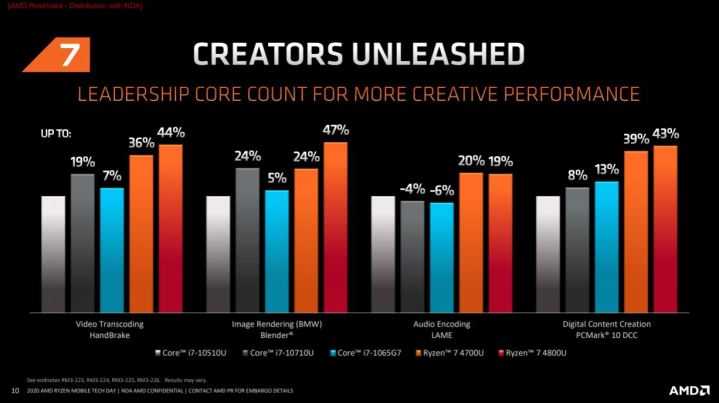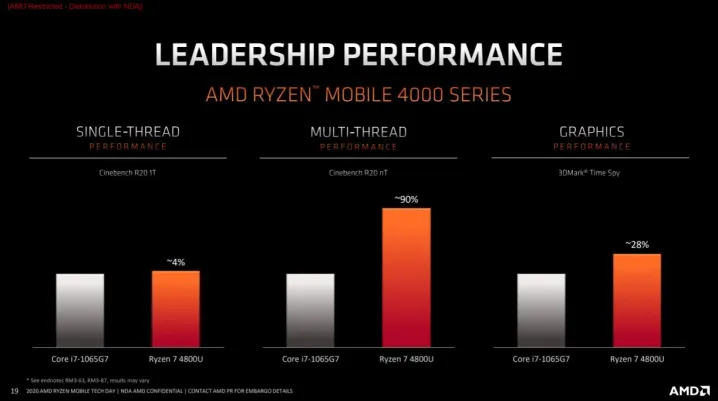“We want a dragster engine in an SUV with Prius fuel efficiency.”
That was AMD’s Scott Swanstrom describing AMD’s new Ryzen 4000 processors in a series of meetings at company headquarters in Austin, Texas.
His wish list sounds like a fantasy car — one that would create a new class of vehicle altogether. That’s exactly the kind of disruption AMD has in mind.
The new Ryzen 4000 series mobile processors aim to upend the current dichotomy in laptops, which is split between portable ultra-thins and larger content creation or gaming machines.
AMD wants Ryzen laptops to do it all.
A new breed of laptop

At its most basic level, the new Ryzen laptop processors bring more cores and higher clock speeds. That might sound like a fairly standard generational leap in processors. But in terms of its standing against Intel and the way it shakes up what’s possible, there are big implications.
On the gaming and content-creation front, these new H-series Ryzen chips mean AMD can compete with Intel’s Core i9 for the first time. Eight cores and 16 threads go head-to-head at the 45-watt profile in laptops like the Dell XPS 15 or MacBook Pro 16-inch.
To seal the deal, AMD even announced the Ryzen 9 4900H, which slightly bumps the frequencies and adds an additional graphics core. Both of these chips have eight cores and 16 threads. For frequency, the Ryzen 9 has a higher base clock, while the Core i9 wins in boost, hitting the coveted 5.0GHz. Then again, with a higher IPC (instructions per clock), comparing clock speeds isn’t apples-to-apples.
That’s good news for AMD. But when you reduce the TDP (thermal design power) to 15 watts and stuff it into a laptop that weighs just 2.2 pounds, you see the true benefit of Ryzen 4000’s architectural gains. A laptop with eight cores and 16 threads obliterates a quad-core in content-creation tasks. It’s not even close.

More cores means significantly better results in content creation, much like with the high core count desktop chips. In tasks like video transcoding or image rendering, AMD’s graphs show that these applications use those extra cores to great effect. It’s more than a 40% increase over Intel’s quad-core processors like the Core i7-10510U or Core i7-1065G7.
Ouch.
So yes, Ryzen 4000 dominates in multi-core performance. But what about single-core? It’s the one area Intel continues to lead (by an admittedly small margin), and it has the greatest impact on gaming performance and other lightly threaded software. Here, AMD claims with Zen 2, Ryzen 4000 is boosted by 25% in Cinebench R20 single-core performance over the previous generation. That’s still true in the limited 15-watt envelope.
The result is a mobile processor that doesn’t fit into the categories currently created by Intel and laptop manufacturers. The Lenovo Yoga Slim 7 is our first taste of this new breed. This $850 laptop has a 14-inch screen, weighs just 2.2 pounds, but comes with the eight-core Ryzen 7 4700U.
Simply put, it’s not the kind of device that cleanly fits into any of the current segments. Even if it’s only the first of its kind, it’s a wake-up call to the current foothold of Intel.
Open up the hood and take a look
Ryzen 4000 is built on the same Zen 2 architecture that allowed AMD to beat Intel on desktop in 2019. These Ryzen 4000 mobile chips get all the benefits of moving to the 7nm process, including 2x performance per watt and a 15% higher IPC.
In other words, they’re more powerful and more efficient. Smaller transistors means more space for them on the die and less power drawn across the board.
Of course, bringing Zen 2 to the laptop requires some serious optimizations to the formula, especially in how it handles power. AMD says it has a “faster and more accurate clock control,” meaning the processor wastes much less energy powering up or powering down. They ramp up faster to an active state, and then quickly fall back to idle, with much less transition time in intermediate power states. The result? More time in idle is less wasted power.
In PCMark, which AMD notes is a burst-filled, difficult test, Ryzen 4000 consumed 59% less power than its predecessor.

On a physical level, these don’t even look all that similar to their desktop counterparts on the surface. Rather than using the celebrated chiplet design of the desktop processors, Ryzen 4 mobile uses just one monolithic die.
That comes as a bit of a surprise. Stitching together smaller CPU dies has helped AMD leap forward on desktop, all while increasing yield and lower production costs. But on mobile, AMD has stated that the benefits are far less. As noted by AnandTech, the ability to keep power levels down is paramount, and with both the CPU and integrated GPU, a chiplet design wasn’t feasible.
AMD says it’s also integrated key elements like LPDDR4X, low power audio, and audio/video decode to achieve what the company calls “breakthrough power efficiency.”
According to AMD, as the architecture was being developed, the engineers kept finding more headroom, adding core upon core upon core. That’s up to eight cores in a thermal profile as small as 15 watts, which is double what you get from both Ryzen 3000 and 10th-gen Intel Ice Lake. These eight cores are each split into two CCX units, though the L3 memory has been reduced to 4MB per CCX, down from the eight of the desktop.
So, that’s the dragster engine. But does AMD’s advances in efficiency make for battery life competitive with Intel’s offerings?
Battery life
Like single-core performance, battery life is an area Intel has largely had the lead in. The huge gains in power efficiency in Ryzen 4000, though, shake things up a bit.
7nm brings all the power down, whether it’s active or idle. AMD says its made strides in lowering the latency of turning the computing cores (or clusters of cores) on or off, both from a hardware and firmware perspective. The result is faster boot times and snappier applications — as well as longer-lasting battery life.

Here, AMD compares the Ryzen 7 4800U in the Yoga Slim 7 with the Core i7-1065G7 in the XPS 13 2-in-1 to show just how far its come in battery life. Even after normalizing the size of the battery to 60 watt-hours, the two devices trade blows. The Ryzen machine wins in web browsing and graphics activity, but loses in idle time and video playback. Losing by 7.5 hours in idle time (connected standby) is the most worrying of the losses here.
AMD is admitting loss here, though it claims the test where it wins is the most valuable. It’s certainly true, as AMD says, that most people spend more time on productivity tasks and web browsing on a daily basis than heavy tasks or video playback.
Still, AMD doesn’t have a clear-cut win here. Battery life is comparable with Intel, but there are clearly use cases where Intel has the upper hand.
Graphics
Thin, non-
But according to AMD, its integrated graphics are still in the lead in most games.

None of these frame rates are particularly exciting if you’re coming from the world of real gaming machines. The numbers listed above are all at low settings in 1080p resolution, and many are still below 60 frames per second. But considering this is all being done without a discrete graphics card on a system as small as the Yoga Slim 7, it’s quite an improvement.
AMD features eight graphics cores, providing a 25% higher peak graphics clock and 77% higher peak memory bandwidth over the previous generation. AMD says it’s a total of 1.79 TFLOPS of peak throughput.
These graphics aren’t, however, built on AMD’s latest Navi graphics. This is still Vega, which uses the older GCN 5 (Graphics Core Next 5) architecture and is nearly two years old at this point.
But AMD maintains that performance per compute unit has increased by almost 60%, allowing for much higher core clocks (all the way up to 1,750MHz). More importantly, as was noted in an interview with Hardware Times, there just wasn’t enough development time to properly integrate Navi. Maybe next time.
For now, AMD’s lead over Intel ranges from 21% in Fortnite all the way up to a whopping 45% in Grand Theft Auto V. In other e-sports games like League of Legends or Counter-Strike: Global Offensive, the two are neck and neck.
I tried out Borderlands 2 in 1080p on the Lenovo Yoga Slim 7, and it struggled. Even with the settings turned down to low, it was only managing around 30 or 35 frames per second and was totally unplayable at medium. It was only pushing smooth frame rates when I moved down to 720p.
I’ll have to do a lot more testing to get a better feel for how these graphics perform on a system like the Yoga Slim 7. It’s on a system like this where they matter most since H-series laptops will have the benefit of discrete graphics.
AMD does have a serious challenge ahead of it. These comparisons are with Ice Lake’s Gen11 graphics, which launched in fall 2019. Later this year, Intel is set to release the most important graphics push in its history, Xe (Gen12). These integrated graphics will show up in Intel’s Tiger Lake processors, and based on what we’ve seen so far, they could put AMD’s integrated graphics to the test.
Of course, creating a more efficient architecture or a higher-core count chip doesn’t win AMD the laptop war. It’ll take deeper partnerships with laptop makers to start eating away at Intel’s dominance. But make no mistake: AMD is shaking up our expectations for what thinner laptops can do, and you’d better believe Intel is paying attention.



